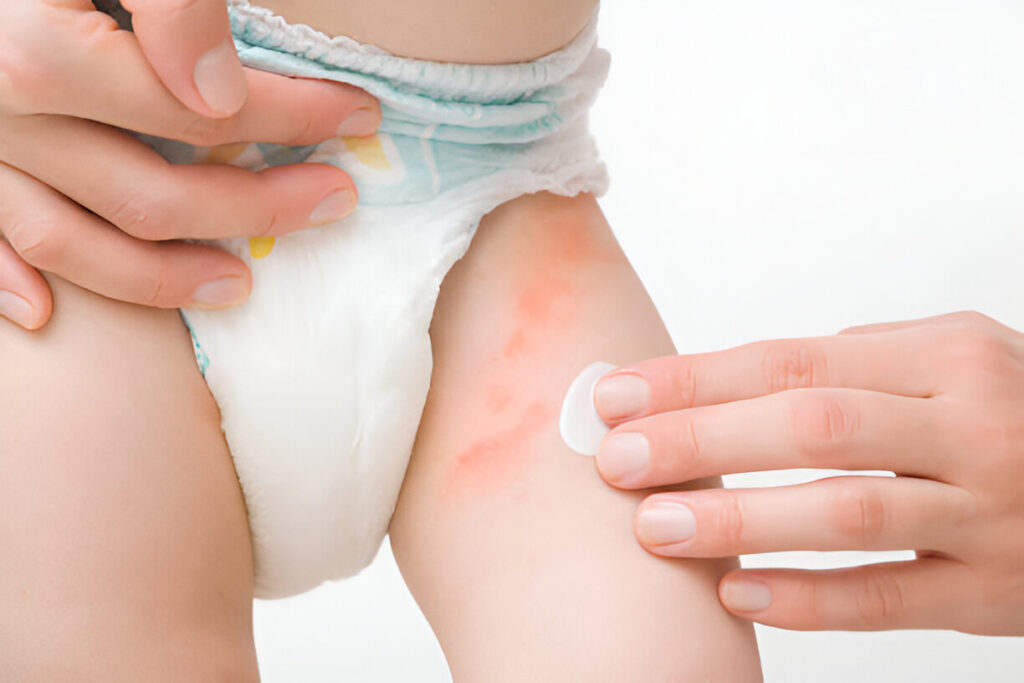Your child may experience discomfort and irritation as a result of chafing, which is a common skin condition that commonly affects infants. Areas of the body where the skin rubs against other skin or clothing, such as the diaper region, the neck, the armpits, and the thighs, are often the places where chafing occurs. In order to prevent and treat chafing in infants, it is necessary to combine practicing proper hygiene, selecting appropriate clothing, and utilizing therapies that are successful. In order to maintain the smoothness and absence of discomfort on your baby’s skin, here are some crucial tips.

Preventing Baby Chafing
1. Keep Skin Clean and Dry
Hygiene Practices
- Regular Baths: Bathe your baby regularly to keep their skin clean and free from sweat and dirt. Use a mild, fragrance-free baby soap to avoid irritation.
- Pat Dry: After bathing, gently pat your baby’s skin dry with a soft towel, paying special attention to skin folds and creases.
Diaper Area Care
- Frequent Diaper Changes: Change diapers frequently to keep the diaper area clean and dry. Prolonged exposure to wet diapers can lead to chafing and diaper rash.
- Air Time: Allow your baby to go diaper-free for short periods to let their skin breathe.
2. Choose Appropriate Clothing
Fabric Choices
- Breathable Fabrics: Dress your baby in loose-fitting, breathable fabrics like cotton. Avoid synthetic materials that can trap heat and moisture.
- Seamless Clothing: Choose clothing with minimal seams and tags to reduce friction against your baby’s skin.
Proper Fit
- Right Size: Ensure that your baby’s clothes and diapers fit properly. Clothing that is too tight can cause chafing, while loose clothing can bunch up and create friction.
3. Use Barrier Creams and Powders
Barrier Creams
- Zinc Oxide Cream: Apply a thin layer of zinc oxide cream to areas prone to chafing, such as the diaper area. It creates a protective barrier that helps reduce friction and irritation.
- Petroleum Jelly: Petroleum jelly is another effective barrier that can keep your baby’s skin protected and moisturized.
Powders
- Cornstarch Powder: Lightly dust cornstarch powder on areas prone to chafing to keep them dry and reduce friction. Avoid talcum powder, as it can be harmful if inhaled.
4. Keep Your Baby Cool
Temperature Control
- Cool Environment: Keep your home cool and well-ventilated, especially during hot and humid weather. Use fans or air conditioning to maintain a comfortable temperature.
- Hydration: Ensure your baby stays well-hydrated, especially in hot weather, to prevent excessive sweating.
Treating Baby Chafing
1. Identify the Chafed Areas
Inspection
- Regular Checks: Inspect your baby’s skin regularly, especially in areas prone to chafing, to catch any signs of irritation early.
- Look for redness and irritation. Chafed skin often appears red and inflamed and may feel warm to the touch.
2. Clean the Affected Area
Gentle Cleaning
- Mild Soap: Gently clean the chafed area with mild, fragrance-free soap and lukewarm water. Avoid scrubbing, as this can further irritate the skin.
- Pat Dry: Pat the area dry with a soft towel, ensuring it is completely dry before applying any treatment.
3. Apply Soothing Treatments
Ointments and Creams
- Aloe Vera Gel: Aloe vera has natural soothing properties that can help reduce inflammation and promote healing. Apply a thin layer to the affected area.
- Hydrocortisone Cream: For severe chafing, a small amount of hydrocortisone cream may help reduce inflammation. Consult your pediatrician before using this treatment.
Natural Remedies
- Coconut Oil: Coconut oil has antimicrobial and moisturizing properties that can soothe chapped skin. Apply a thin layer to the affected area.
- Calendula Cream: Calendula cream is known for its healing properties and can be applied to chafed skin to reduce irritation and promote healing.
4. Ensure Proper Ventilation
Air Exposure
- Diaper-Free Time: Allow your baby to spend time without a diaper to let the skin breathe and promote healing.
- Loose Clothing: Dress your baby in loose-fitting, breathable clothing to reduce friction and irritation.
5. Monitor and Seek Medical Advice
Monitoring
- Track Progress: Monitor the affected area regularly to ensure it is healing. Look for signs of improvement, such as reduced redness and irritation.
- Prevent Infection: Keep an eye out for signs of infection, such as increased redness, swelling, or pus.
Medical Advice
- Consult a Pediatrician: If the chafed area does not improve within a few days or appears to be getting worse, consult your pediatrician for advice. They may recommend specific treatments or identify underlying causes that need to be addressed.
FAQs
1. What causes chafing in babies?
Chafing in babies is typically caused by friction, moisture, and heat. It often occurs in areas where skin rubs against skin or clothing, such as the diaper area, neck, armpits, and thighs.
2. How can I prevent diaper chafing?
Prevent diaper chafing by changing diapers frequently, allowing diaper-free time, and applying barrier creams like zinc oxide or petroleum jelly to protect the skin.
3. Is it safe to use powder on my baby’s skin?
Cornstarch powder is safe to use and can help keep your baby’s skin dry. Avoid using talcum powder, as it can be harmful if inhaled.
4. What home remedies can soothe chafed skin?
Home remedies like coconut oil, aloe vera gel, and calendula cream can soothe chafed skin and promote healing. Apply these remedies gently to the affected area.
5. When should I seek medical advice for baby chafing?
Seek medical advice if the chafed area does not improve within a few days, appears to be getting worse, or shows signs of infection, such as increased redness, swelling, or pus.
According to these guidelines, you will be able to properly prevent and treat chafing in your infant, thereby ensuring that your child remains comfortable and content. When it comes to preventing chafing and fostering healthy skin, it is important to keep in mind that maintaining proper cleanliness, using the appropriate products, and keeping your baby’s skin cool and dry are all essential.







